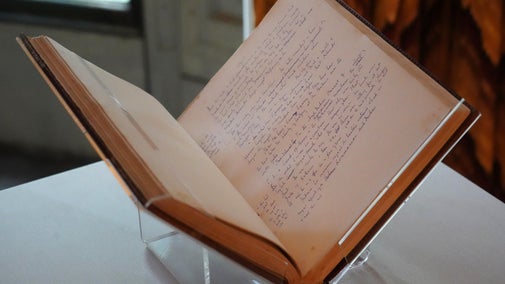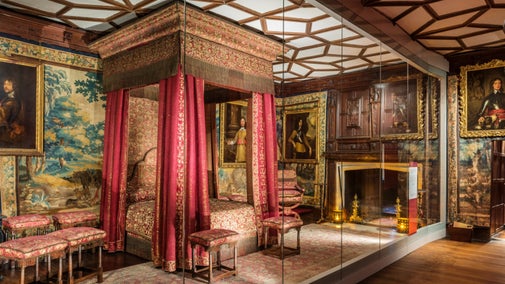
Knole's collections
Explore the objects and works of art we care for at Knole on the National Trust Collections website.

Victoria Mary Sackville-West, known as Vita, was born at Knole in 1892 and grew up there, the only child of Lionel Edward Sackville-West (later 3rd Baron Sackville) and his cousin, Victoria Sackville-West. She loved Knole but was unable to inherit the estate due to the laws of primogeniture dictating that only men could inherit property.
As a young girl, Vita delighted in showing visitors around Knole, and she expressed profound attachment to the estate throughout her life. It was therefore a constant source of distress to her that she was unable to inherit her ancestral home.
Vita's uncle Charles inherited the title and Knole, and it was during his term that the house was handed to the National Trust with an endowment during the 1940s. The Sackville family retained a 200-year lease on private apartments at Knole and still live here today.
If you pause at the foot of the Great Staircase as you leave the Great Hall, you will be rewarded with the sight of a large carved oak door stop in the form of William Shakespeare, which is from Vita's bedroom at Knole. Her mother's passion for fresh air meant that all the doors in the house were kept open.
Vita was a poet, gardener, novelist, biographer and journalist. Her love for Knole led her to write a history of the house and her family, Knole and the Sackvilles. One of her best-known novels, The Edwardians, uses Knole as inspiration for the grand house Chevron.
Her long narrative poem, The Land, won the Hawthornden Prize in 1927, the oldest British literary prize. Then in 1933 she became the only writer to win it a second time with her Collected Poems.
In 1947, Vita was made a Companion of Honour for her services to literature. Her weekly column in The Observer called 'In Your Garden', became a garden writing classic, and she was also a founding member of Knole's garden committee.

Vita was married in 1913 at the private chapel in Knole. Her husband, Harold Nicolson, was a diplomat, politician, critic and biographer. They went on to buy Sissinghurst Castle in a practically derelict state. Together, they rebuilt the house and designed the now world-famous garden, visited by keen gardeners from all over the world.
Vita and Harold remained close throughout a relatively unorthodox marriage. Both had affairs with members of the same sex and Vita's relationship with Virginia Woolf is celebrated in Woolf's novel, Orlando (1928), inspired by Knole and Vita's inability to inherit her beloved family home.
The original manuscript for Orlando is inscribed 'Vita from Virginia' and remains at Knole today. Vita's son, Nigel Nicolson, has described it as 'the longest and most charming love-letter in literature.'
Vita began speaking to the National Trust in 1928 and helped to negotiate it taking over Knole in the early 1940s. She became, along with Harold (who served as Executive Council vice-chairman), a member of the Trust’s council.
Vita loved the harmony of Knole with its picturesque setting, describing it as 'not an incongruity like Blenheim or Chatsworth, foreign to the spirit of England... the great Palladian houses of the 18th century are in England, they are not of England'.
This article contains contributions from Allison Adler Inglis-Taylor from the University of Oxford. Allison specialises in English literature, history, and culture from 1800 to the present day, and also has research interests in political history and theatre. She enjoys forging connections between her research in heritage studies and the history of the countryside with institutions that conserve historical sites and landscapes.

Explore the objects and works of art we care for at Knole on the National Trust Collections website.
Virginia Woolf's 'Orlando' was inspired by Vita Sackville-West and Knole. A project to digitise the original manuscript means it is now accessible online.

Vita Sackville-West, known as Vita, spent her childhood living at Knole. At the age of 18, she had come of the age for a suitable marriage to be made. However, Vita knew that this would signify her having to leave her beloved ancestral home forever.

Knole has been home to and shaped by people who challenged conventional ideas of gender and sexuality. Discover their stories and the challenges they faced.

Discover the life of prolific writer and passionate gardener Vita Sackville-West and her husband Harold Nicolson at Sissinghurst Castle Garden.

Women weave a fascinating and rich thread throughout Knole's history. Often wealthy and powerful in their own right, they left their mark on Knole, a legacy that remains today.

Knole is full of treasures and was designed to impress its visitors. Originally an archbishop’s palace, then Royal residence, now home to the Sackville family for over 400 years.
